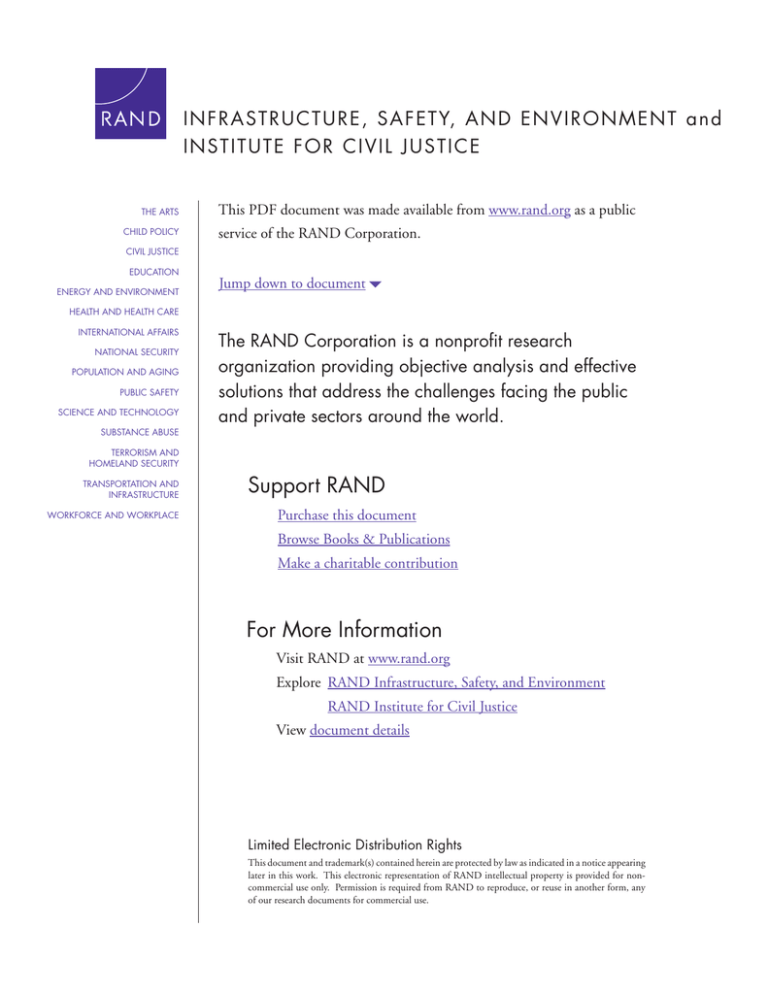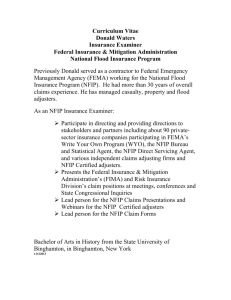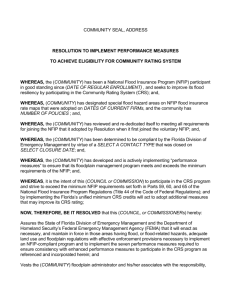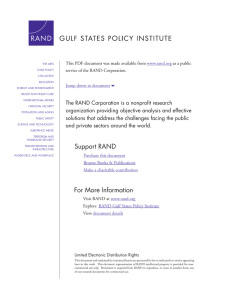
INFRASTRUCTURE, SAFETY, AND ENVIRONMENT and
INSTITUTE FO R CIVIL JUSTICE
THE ARTS
CHILD POLICY
This PDF document was made available from www.rand.org as a public
service of the RAND Corporation.
CIVIL JUSTICE
EDUCATION
ENERGY AND ENVIRONMENT
Jump down to document6
HEALTH AND HEALTH CARE
INTERNATIONAL AFFAIRS
NATIONAL SECURITY
POPULATION AND AGING
PUBLIC SAFETY
SCIENCE AND TECHNOLOGY
SUBSTANCE ABUSE
The RAND Corporation is a nonprofit research
organization providing objective analysis and effective
solutions that address the challenges facing the public
and private sectors around the world.
TERRORISM AND
HOMELAND SECURITY
TRANSPORTATION AND
INFRASTRUCTURE
WORKFORCE AND WORKPLACE
Support RAND
Purchase this document
Browse Books & Publications
Make a charitable contribution
For More Information
Visit RAND at www.rand.org
Explore RAND Infrastructure, Safety, and Environment
RAND Institute for Civil Justice
View document details
Limited Electronic Distribution Rights
This document and trademark(s) contained herein are protected by law as indicated in a notice appearing
later in this work. This electronic representation of RAND intellectual property is provided for noncommercial use only. Permission is required from RAND to reproduce, or reuse in another form, any
of our research documents for commercial use.
This product is part of the RAND Corporation technical report series. Reports may
include research findings on a specific topic that is limited in scope; present discussions of the methodology employed in research; provide literature reviews, survey
instruments, modeling exercises, guidelines for practitioners and research professionals, and supporting documentation; or deliver preliminary findings. All RAND
reports undergo rigorous peer review to ensure that they meet high standards for research quality and objectivity.
The Lender-Placed
Flood Insurance Market
for Residential Properties
Lloyd Dixon, Noreen Clancy,
Bruce Bender, Patricia K. Ehrler
Prepared for the Mitigation Division of
the Federal Emergency Management Agency
Approved for public release; distribution unlimited
The research described in this report was sponsored by the Mitigation Division of the
Federal Emergency Management Agency under contract number HSFEHQ-04-F-0431.
Library of Congress Cataloging-in-Publication Data
978-0-8330-4155-5
The RAND Corporation is a nonprofit research organization providing objective analysis
and effective solutions that address the challenges facing the public and private sectors
around the world. RAND’s publications do not necessarily reflect the opinions of its research
clients and sponsors.
R® is a registered trademark.
© Copyright 2007 RAND Corporation
All rights reserved. No part of this book may be reproduced in any form by any electronic or
mechanical means (including photocopying, recording, or information storage and retrieval)
without permission in writing from RAND.
Published 2007 by the RAND Corporation
1776 Main Street, P.O. Box 2138, Santa Monica, CA 90407-2138
1200 South Hayes Street, Arlington, VA 22202-5050
4570 Fifth Avenue, Pittsburgh, PA 15213-2665
RAND URL: http://www.rand.org/
To order RAND documents or to obtain additional information, contact
Distribution Services: Telephone: (310) 451-7002;
Fax: (310) 451-6915; Email: order@rand.org
Summary
The National Flood Insurance Program (NFIP) provides the majority of flood insurance on
residential properties in the United States.1 While insurance agents sell nearly all NFIP policies
through private insurance companies, NFIP policies are still underwritten by the federal government. Flood insurance is also available from private insurers that assume the risk of losses
themselves. However, little systematic information is available about the size of the private
market, how the policies offered by private insurers compare with those offered by the NFIP,
or the reasons buyers choose private market policies over federal program policies. This report
provides information in each of these three areas.
Overview of the Private Market for Residential Flood Insurance
Established by Congress in 1968, the NFIP makes flood insurance available to homeowners,
renters, and businesses in communities that participate in the NFIP. Such communities agree
to adopt and enforce a floodplain management program aimed at reducing flood losses. Early
in the program, the federal government found that making insurance available was not sufficient to induce large numbers of people to purchase flood insurance, and, in the Flood Disaster Protection Act of 1973, Congress established the mandatory purchase requirement (MPR).
The MPR requires homeowners in areas at high flood risk to purchase flood insurance if they
have a mortgage with a federally regulated lender. Lenders must ensure that the property is
covered by flood insurance for the term of the loan and are required to purchase flood insurance on behalf of the property owner if the property owner fails to do so.
Private insurers provide flood insurance through the voluntary and the lender-placed
markets. In the voluntary market, homeowners choose whether to purchase flood insurance
underwritten by private insurers or the NFIP. Only a few private insurers offer policies in the
voluntary market, and the number of policies written outside the NFIP remains very small. In
1991, the NFIP introduced a special program to enable lenders to more easily force-place policies: the Mortgage Portfolio Protection Program (MPPP). However, the MPPP policy is little
1
The Federal Emergency Management Agency (FEMA), which is part of the U.S. Department of Homeland Security
(DHS), runs the NFIP.
xiii
xiv
The Lender-Placed Flood Insurance Market for Residential Properties
used now, and, instead, lenders for the most part force-place policies that private sector insurers
underwrite. This study focused on the size and characteristics of this lender-placed market.2
Large lenders subject to the MPR typically hire firms referred to as trackers to monitor
whether the homes in their portfolios carry the required amounts of flood and other insurance.
If a home in a high-risk flood area lacks insurance, trackers often first call to confirm whether
the home has flood insurance and then send out a series of letters that culminates in the force
placement of flood insurance if the homeowner fails to purchase insurance. Federal regulation
requires a 45-day notice period before force-placing flood insurance.
Size of the Lender-Placed Flood Insurance Market
To develop estimates of the number of lender-placed policies that private insurers underwrite,
we collected data from a sample of lenders, trackers, and insurers. While the sample sizes were
not large (four insurers, four trackers, and five lenders), the insurers and trackers participating
in the study represent a sizable share of the lender-placed market by policies issued and loans
tracked.3 The lenders participating in the study represent a modest share of the market by loan
volume. We used methods detailed in the report to extrapolate the number of policies that
participating firms reported to the industry as a whole.
As shown in Table S.1, estimates based on the different data sources are internally consistent and point to between roughly 130,000 and 190,000 private lender–placed flood insurance policies. The figures count only primary flood insurance policies—that is, policies that
assume that no other flood coverage on the property. Lenders were not able to provide data on
policies in place on second mortgages and home equity loans, and adjustments were made to
estimate the number of such policies. Construction of quantitative measures of the statistical
Table S.1
Estimated Number of Primary Lender–Placed Flood Insurance Policies Written by Private Insurers
Source of Data Used for Estimate
Policies in Place (thousands)
Insurers
128 to 187
Lenders
Excluding second mortgages and home equity loans
110
With adjustment to account for second mortgages and home equity loans
154
Trackers
142
NOTE: Estimates reflect policies in place some time between mid-2004 and early 2006.
2
Private insurers provide flood insurance for most commercial structures and, in contrast to practices for residential
structures, provide it through the voluntary market rather than the mandatory market. Investigation of the size of the flood
insurance market on commercial studies was outside the scope of this study.
3
Knowledgeable stakeholders interviewed for the project indicated that eight insurers write the vast majority of lenderplaced flood insurance policies and that seven firms track the vast majority of loans tracked by the tracking industry.
Summary
xv
uncertainty of the estimates was beyond the scope of this study, but the consistency of the estimates across the different data sources increases confidence in the findings.
Private insurers also appear to write a sizable number of gap policies, although the data on
gap policies are sketchy. Gap policies add to the coverage of an existing flood insurance policy
and are issued when the lender determines that there is insufficient coverage. Including gap
policies may increase the number of private policies to between 180,000 and 260,000. This
prediction is quite speculative, however, and further investigation of the number of gap policies is warranted. Gap policies do not increase the total number of households covered by flood
insurance but rather increase the dollar amount of flood insurance in place.
The number of private policies is not large compared with the 5.0 million residential
policies written by the NFIP. Including this relatively small number of private policies thus
does not result in a large increase in estimates of the proportion of structures covered by flood
insurance.4 However, the number of policies currently in place is not the only measure of private insurers’ importance in implementing the MPR. First, few lender-placed policies remain
in effect for the one-year policy term, with the implication that far more policies are issued per
year than the number of policies currently in place indicates. Second, the automatic coverage
endorsement that many lenders purchased increases the number of homes effectively insured
beyond the number of policies in place.5
Comparison of Private and NFIP Policies
Private policies used to satisfy the MPR must meet or exceed coverage provided by NFIP policies. To assess whether private policies satisfy this requirement, we compared the provisions of
five private policies with the standard flood insurance policy used by the NFIP (the policy that
lenders can place through the NFIP’s MPPP).
The administrative features of private policies are, for the most part, broader or more
flexible than those of the NFIP policy. Private insurers offer several optional endorsements
and provide features such as backdating, gap policies, and automatic coverage that enhance
a lender’s ability to tailor the coverage to its portfolio’s particular characteristics. In terms of
administrative features, the only area in which private policies are more limited is the appeal
of claims payments.
Private policies provide broader coverage for some risks than the NFIP policy does but
provide less broad coverage for other risks. On the one hand, private policies cover mudslides,
while the MPPP policy does not. On the other, some private policies have stronger mold exclusions than the NFIP policy has. In addition, the private policies reviewed do not cover testing,
4
Dixon, Clancy, et al. (2006, p. 15) estimated that 1.76 million of the 3.57 million single-family homes in Special Flood
Hazard Areas (SFHAs) carry policies from the NFIP (49 percent). If private lender–placed policies increase the number of
single-family homes insured by 160,000, the market penetration rate for flood insurance (including both NFIP and nonNFIP policies) would rise to 54 percent.
5
With the automatic coverage endorsement, all homes in the lender’s portfolio subject to the MPR are in effect covered
for losses.
xvi
The Lender-Placed Flood Insurance Market for Residential Properties
monitoring, or cleanup of pollution that occurs during a flood event, while the NFIP policy
covers cleanup even though it excludes coverage for testing and monitoring.
We also found that, in terms of the types of and limits on losses that private policies
cover, private policies compare favorably with the NFIP policy in many dimensions, but they
also come up short in a few. Areas in which the private policies reviewed meet or exceed NFIP
policy provisions include
• the policy limit on structure coverage
• situations in which the policy pays replacement cost rather than actual cash value of the
loss
• additional living expenses
• basement coverage.
Areas in which the provisions of some private policies were more restrictive than the
NFIP policy include
• debris removal
• coverage for loss avoidance measures
• limits on increased cost of compliance coverage.
The failure to meet or exceed NFIP policies in some dimensions raises the possibility that
some private policies do not comply with MPR requirements. It is up to policymakers to assess
whether these differences are significant. Some of the private policies may have been updated
since we obtained the policies (early to mid-2005), and additional research is warranted on the
extent to which coverage in these dimensions has improved over time.
Perceptions of the Advantages of the Private Market
We interviewed lenders, insurers, and trackers about the advantages and disadvantages of forceplacing policies through the private market rather than through the NFIP. We interviewed 11
firms in total, either in person or via phone.
Private policies offer a number of features attractive to lenders that NFIP policies do not.
The stakeholders interviewed highlighted the ability to backdate private policies to the start
of the letter cycle and the automatic coverage endorsement. They also praised the service that
private insurers provided and the ease of using their products. Lenders appeared very satisfied
with the products and services that private insurers provided and expressed no interest in using
the MPPP to force-place policies. The MPPP would need to change in fundamental ways to
attract private lenders and trackers to use it.
Summary
xvii
Role of Private Insurers
Congress established the NFIP in part due to the ongoing unavailability of private flood insurance. Over the years, however, a deepening partnership has emerged between the federal government and the private insurance industry. The primary role the private insurance industry
plays in providing flood insurance to residential structures is to administer the NFIP. However, private insurers underwrite flood insurance in a limited, but important, niche. In doing
so, they increase the number of homes protected by flood insurance, developing innovative
policy provisions that respond to lender and borrower needs and providing streamlined services that reduce the costs lenders incur in complying with the MPR.







